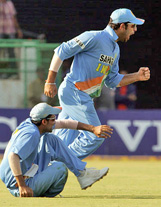COACHING
Indian Fielding - The revolution is on!!!
I recently had the opportunity to watch an U-13 match at the famous Bombay Gymkhana ground. An abiding memory of the game is young enthusiastic cricketers dressed in orthodox whites throwing themselves in all directions on a lush green outfield. It was an indication of the extent to which fielding has improved at all levels of the game in India.
Mohammed Kaif (left) Yuvraj Singh
At the forefront of India's fielding revolution.
Indian teenagers have had the advantage of growing
up in the Television Era. Besides the lessons
imparted to them by their coaches, they are also
able to acquire tips from their heroes, whom they
can see in action from every possible angle on the
TV monitor. They try to imitate their idols on the
field of play. This exposure to the highest level
of the game has helped them tremendously.
Indian cricket in the bygone days was indifferent to fielding. One got into the team on the basis of runs scored or wickets taken, and fielding was never given due weightage. Some of our greatest players abhorred the word "fielding". They would look to scurry into the dressing-room to avoid being out on the field at the slightest opportunity! The consensus was that batting and bowling were the all-important departments, and fielding an unavoidable chore.
Indian cricket in the bygone days was indifferent to fielding. One got into the team on the basis of runs scored or wickets taken, and fielding was never given due weightage. Some of our greatest players abhorred the word "fielding". They would look to scurry into the dressing-room to avoid being out on the field at the slightest opportunity! The consensus was that batting and bowling were the all-important departments, and fielding an unavoidable chore.
Another factor detrimental to the evolution of fielding in India was the coarseness of grounds. Even today, most grounds at the grass-root level of the game are devoid of grass. They are dry and rough, and the water-shortage in some areas of the country only makes things worse. Fielding on such grounds can be a hurtful experience rather than a pleasurable one.
In the past, a majority of first-class matches were played on government-owned multi-purpose grounds. These grounds staged different sports and also concerts and exhibitions right through the year. Consequently, the local cricket authorities got hardly any time to roll and water the arena and prepare it for a match. Club matches were played on uneven, uncultivated grounds that lacked even a proper boundary. There were stones and rubbish all around and fielding in the deep was a perilous proposition.
I remember an incident that took place during a Times of India Shield match at the Parsee Gymkhana Ground in Mumbai. We had got a new recruit from Nagpur, Anil Deshpande, who did extremely well at the first-class level and went on to become a national selector. He was fielding in the covers, when the batsman got the ball past him. Deshpande chased it and had almost cut it off when he banged himself into a wall he had not noticed. So badly did he injure himself that he had to be taken to hospital to get his wounds stitched.
Injuries were also sustained when one's foot would get stuck in a hole, or the ball would hit a stone and bounced sharply just as you were about to field it. There were also instances of enterprising fielders having to leave the field in pain after jumping to stop the ball and landing on a sharp stone or a broken piece of glass instead.
These sub-human conditions were the reason for Indian fielding never coming close to Australian, South African or even English standards. Coaches could never practically demonstrate a good effective dive or a sliding stop.
Add to this the mental block against fielding. There was a famous incident on India's tour of Australia in 1947-48, wherein an Indian fielder made a half-hearted attempt to stop a stroke played by Bradman. When confronted by his teammates, he argued that he hadn't stopped the ball as that particular stroke played by the great man deserved a boundary! The Indians of that time also had an inferiority complex regarding their stamina and mental toughness. All this meant that there was no way the Indian bowlers could depend on the fielders to help them take twenty opposition wickets. Consequently, Indian cricket suffered.
Today, times have changed. Youngsters seem to be as interested in fielding as they are in batting or bowling. Jonty Rhodes, Ricky Ponting and others have had an inspirational effect. Even the coaches are being specifically trained in imparting techniques and exercises to enhance their pupils' movement and suppleness. The conditions at grounds where the most talented junior cricketers are trained have improved considerably, and qualified physios and fitness experts are part of the coaching process. Young cricketers have become fitter, tougher and confident as a result.
Slow movers will soon be history in Indian cricket. Mohammed Kaif and Yuvraj Singh, two young men who spent their formative years in the TV era and undoubtedly watched the likes of Rhodes, have shown scores of youngsters the way. Even as I write this, I know that somewhere in the land, a 12 year-old has snapped up a blinder at forward short-leg, or flung himself to take a splendid catch in the outfield.
We are in the midst of a fielding revolution in India. The quicker everyone connected with Indian cricket realizes the importance of saving 25-30 runs, the better. The last World Cup was won by the most consistent fielding side of the tournament. The same was the case in 1999. 2007 should be no different.